Overcurrent devices protect the circuit conductors and conductor insulation from overheating. They also limit the damage associated with overheating and faults in downstream equipment. Fuses performed this function during the first days of electrical distribution, but circuit breakers of ever increasing sophistication have been available since the early 1900s. This paper focuses on circuit breakers and describes the wide variety of available devices. The emphasis is on low-voltage residential, industrial and commercial applications where the circuit voltages range from 120 volts through 600 volts. This is the area that is commonly encountered by electrical inspectors. The residential area is principally served by single and two-pole molded-case circuit breakers while the industrial and commercial world is principally served by higher current single and two-pole breakers and by three-pole molded-case circuit breakers. The paper also discusses low-voltage power circuit breakers and medium-voltage vacuum circuit breakers. The paper concludes with a brief description of the protective functions available with electronic trip devices. These include trip units with adjustable settings and with integrated ground-fault detection, and circuit breakers with communication capabilities to remote monitors including via the Internet. Electronics also bring additional safety features to the industrial and commercial area such as zone-interlocking between molded-case circuit breakers and power breakers, and additional safety features to the residential area such as ground-fault circuit interrupters and arc-fault circuit interrupters combined with residential circuit breakers.
Introduction

Figure 1. An interior view of a typical single-pole miniature circuit breaker
Since the subject of this paper is overcurrent protection, the paper first addresses the meanings of the words “overload” and “overcurrent.” There is also a brief description of the method used for circuit interruption; namely, arc extinction within the circuit breaker. The paper then focuses on residential circuit breakers, sometimes referred to as miniature circuit breakers, followed by a description of industrial/commercial molded-case circuit breakers. This includes a discussion of molded-case circuit breaker maintenance. There is a subsequent description of low-voltage power circuit breakers, and of medium-voltage vacuum circuit breakers. The paper concludes with a discussion of the role of electronics in circuit protection, including reference to the latest developments in communications capability via the Internet, and mention of new safety devices such as arc-fault circuit interrupters.
Overcurrent Protection and Arc Interruption
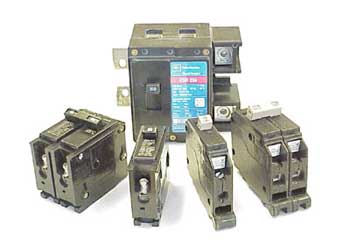
Figure 2. The typical continuous current range is 15 A – 225 A and the typical short-circuit-current ratings are 10 k -42 k A. Representative residential circuit breakers appear
All circuit breakers have the primary function of protecting the circuit conductors by detecting and interrupting overcurrents. Such faults can involve relatively modest currents such as overloads, or the large short-circuit overcurrents associated with faults between conductors. The definitions of terms from the National Electrical Code1 are as follows:
Overcurrent.Any current in excess of the rated current of equipment or the ampacity of a conductor. It may result from overload, short circuit, or ground fault.
Overload.Operation of equipment in excess of normal, full-load rating, or of a conductor in excess of rated ampacity that, when it persists for a sufficient length of time, would cause damage or dangerous overheating. A fault, such as a short circuit or ground fault, is not an overload.
The IEC definition of overload2 provides additional clarity:
Overload. Operating conditions in an electrically undamaged circuit, which cause an overcurrent.
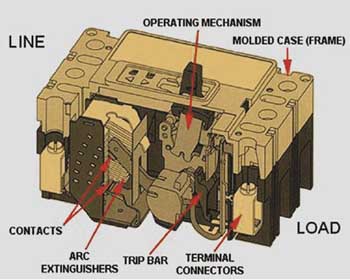
Figure 3. An outline of a three-phase molded-case circuit breaker
All circuit breakers interrupt current by separating current-carrying contacts. An electrical arc is established at the last point of contact and, in an alternating-current circuit, this arc conducts the circuit current until the current wave passes through zero. The arc plasma is comprised of ionized ambient material, for example, air and metal vapor, and has temperatures exceeding 5000 degrees C. The arc continuously receives power from the circuit as measured by the arc voltage multiplied by the arc current, and continually loses power due to thermal-conduction, radiation, and convection. At current zero, the power input is removed, the contact-polarity is reversed, and there is a race between the factors that tend to cool the arc plasma and the factors such as the circuit voltage that tend to cause arc reignition. It must be noted that controlled arcs, within overcurrent devices, perform an extremely useful function. If arc creation did not occur during contact separation, the circuit current would collapse to zero instantaneously causing high overvoltages in inductive elements such as motors and transformers. Circuit breakers are designed to interrupt short-circuit fault currents ranging from 10 kA in residential branch circuits through 200 kA in industrial and commercial circuits, and much of this design involves control of the associated high current arc within the circuit breaker, with arc extinction and circuit interruption at current zero.
Residential Molded-Case Circuit Breakers
Residential overcurrent protective devices such as miniature circuit breakers are designed to protect circuit conductors by opening automatically before conductor damage is caused by excessive I-squared-t ohmic heating. Protection is achieved by having the response curve of the breaker, the time-current curve, lower than the corresponding thermal damage characteristics for the conductor. In common with most circuit breakers, a charged spring causes the contacts to separate when the mechanism is tripped.
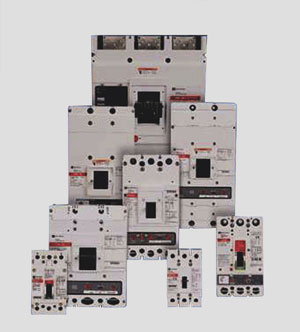
Figure 4. A range of industrial/commercial molded-case circuit breakers
Residential circuit breakers are thermal-magnetic devices. For low-current overloads, the breaker trips due to the heating of an internal bimetal. For short-circuit-fault currents, the circuit breaker must respond more rapidly, and the breaker trips “instantaneously” due to internal magnetic forces. An interior view of a typical single-pole miniature circuit breaker appears in figure 1.
Thermal trip action is achieved through the use of a bimetal heated by the load current. A bimetal consists of two strips of metal bonded together. Each strip has a different thermal rate of heat expansion. Heating of the bimetal due to overload current will cause the bimetal to bend or deflect. The metal having the greater rate of expansion will be on the outside of the bend curve. On a sustained overload, the deflecting bimetal will physically push the trip bar, causing the operating mechanism to unlatch. The time needed for the bimetal to bend, to unlatch the mechanism and to trip the circuit breaker, varies inversely with the current.
Magnetic trip action is achieved through the magnetic forces associated with high short-circuit-fault currents. An armature moves in response to these forces, unlatches the mechanism and causes the breaker to trip.
Residential circuit breakers are qualified to UL 4893 and are a general category4 that includes single and two-pole circuit breakers with continuous currents of 225 A or less, and with voltage ratings of 120 V, 127 V, 120/240 V. These breakers may also be used in industrial/commercial applications. The typical continuous current range is 15 A–225 A and the typical short-circuit-current ratings are 10 kA–42 k A. Representative residential circuit breakers appear in figure 2.
Industrial/Commercial Molded-Case Circuit Breakers
An outline of a three-phase molded-case circuit breaker is shown in figure 3. The function of the molded-case (frame) is to provide an insulated housing to mount all of the components. The operating mechanism opens and closes the three sets of contacts simultaneously (common-trip), and is driven by a spring-loaded mechanism. The springs are charged by moving the handle first to the “off” position and then to the “on” position. The motion of a trip-bar trips the mechanism and, in a thermal-magnetic breaker, this motion is again initiated either by a bimetal or by a magnetic trip. In figure 3, each pole contains an electromagnet whose winding is in series with the load current. When a short-circuit fault occurs, the current passing through the circuit conductor causes the magnetic-field-strength of the electromagnet in the breaker to rapidly increase and attract the armature. As the armature is attracted to the electromagnet, the armature rotates the trip bar causing the mechanism to unlatch and the circuit breaker to trip.
In each pole there is typically one stationary and one moveable contact. On tripping, an arc is drawn between the separating contacts, and this arc is then controlled by the arc extinguishers (arc chutes) with interruption at current zero. Industrial/commercial molded-case circuit breakers can be equipped with many features. The larger frame sizes are frequently equipped with electronic trip units to permit greater control of the time-current tripping characteristics. This permits, for example, precise coordination between overcurrent devices connected in series. Electronic trip units can also be designed to detect ground faults and earth leakage currents, and units equipped with communication capabilities can send circuit breaker status information, and additional information such as circuit energy consumption, to distant monitors or remote data acquisition systems.
All three-pole circuit breakers, and one and two-pole breakers with ampere ratings over 225 A and voltage ratings above 240 V, are usually categorized4 as industrial/commercial circuit breakers. These circuit breakers are also qualified to UL 4893. An important sub-category is the current limiting circuit breaker that is designed to cause an extremely rapid build-up of arc voltage. These breakers4, when operating within their current-limiting range, limit the let-through I-squared-t to a value less than the I-squared-t of a half-cycle wave of the symmetrical prospective short-circuit-fault current.
Typical industrial/commercial circuit breakers frame sizes range from 125 A– 3000 A, typical voltages range from 120 V – 600 V and typical short-circuit-current ratings range from 10 kA – 200 kA. Figure 4 shows a range of industrial/commercial molded-case circuit breakers.
Three major features of circuit breakers are 1) they are common trip and consequently isolate all phases of the circuit, 2) they can be provided with electronic enhancements, and 3) they can be reset multiple times without replacement. Since molded-case circuit breakers are not intended to be opened for examination and maintenance, the life and maintenance of these re-settable circuit breakers will be addressed.
All overcurrent protective devices need to be maintained. They need to be housed in an appropriate environment, and their condition needs to be checked periodically. In particular, when an overcurrent protective device operates automatically, good practice dictates that the source of the overcurrent should be located, and that the condition of the overcurrent protective device should be checked prior to circuit re-energization. The specific requirements for molded-case circuit breaker maintenance and the associated considerations for circuit breaker life are as follows.
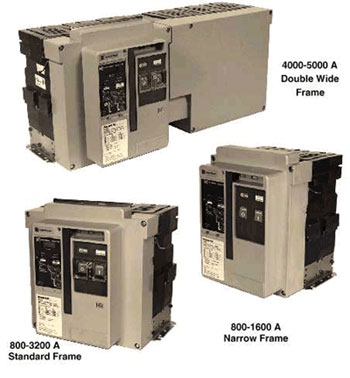
Figure 5. Representative low-voltage power circuit breaker frames
When appropriately maintained, molded-case circuit breakers provide reliable protection for many years. The exact lifetime of the breaker, however, is determined by the circuit breaker’s operational duty and by its environment. With respect to operational duty, for most circuits there will be occasional overload conditions or low-current fault conditions. Here the operating life will be tens of years. In other circuits, there will be occasional high short-circuit-current faults. This will reduce the circuit breaker’s operating life and may necessitate circuit breaker replacement. Here it is noted that molded-case circuit breakers, when evaluated according to the standard UL 489 “Molded-case Circuit Breakers, Molded-case Switches, and Circuit Breaker Enclosures”3, are subjected to bolted fault conditions at maximum short-circuit-current rating in two separate tests. Thus circuit breakers have a finite interrupting capability, and breakers that experience multiple high short-circuit-current faults should receive a thorough inspection with replacement if necessary.
With respect to environmental effects, circuit breakers are sometimes exposed to high ambient temperatures, to high humidity and to other ambient conditions that are hostile to long performance. For example, industries may have corrosive environments or could be associated with dusty environments that could affect operating parts.
It is not intended that molded-case circuit breakers be disassembled for inspection. However, the condition of molded-case circuit breakers can be evaluated by using NEMA AB4 “Guidelines for Inspection and Preventive Maintenance of Molded-case Circuit Breakers used in Industrial and Commercial Applications.”5
This document should be referenced during periodic maintenance or during specific inspection following a high short-circuit-current fault. The document is intended to ensure that molded-case circuit breakers are well maintained, and provides guidelines for circuit breaker replacement.
NEMA AB4 is divided into separate sections dealing with:
- Inspection Procedures
- Preventive Maintenance
- Test Procedures
- Accessory Device Test Procedures
The section dealing with Inspection Procedures describes thermal and visual checks of the circuit breaker’s condition. Overheating of the circuit breaker would necessitate further investigation, and cracks in the molded case would certainly necessitate circuit breaker replacement.
The section dealing with Preventive Maintenance insures that the circuit breaker’s life is not compromised by external conditions. The objectives are that the circuit breaker operates in a clean environment, that the connections at the terminals are torqued properly and are in good condition, and that the circuit breaker is correctly wired.
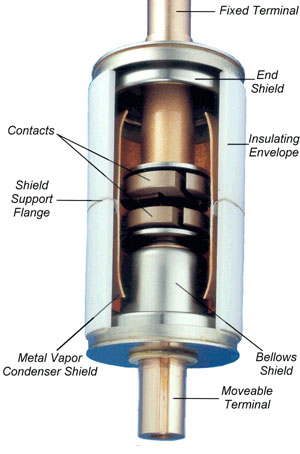
Figure 6. As indicated in the cut-away view of figure 6, two contacts oppose each other within a vacuum envelope
The section dealing with Test Procedures deals with non-destructive tests that can be used to verify specific operating characteristics of molded-case circuit breakers: Mechanical Operation Test, Insulation Resistance Test, Individual Pole Resistance Test (millivolt drop test), Inverse Time Overcurrent Test, Instantaneous Overcurrent Trip Test, and Rated Hold-In Test. Non- compliance of one or more of these tests could lead to circuit breaker replacement.
In summary, following an automatic overcurrent interruption, the condition of any protective device should be checked prior to circuit re-energization. For molded-case circuit breakers, the condition of the circuit breaker is assessed without opening or disassembling the breaker. For tripping events caused by overloads and low-current faults, evaluation usually takes the form of visual inspection and mechanical operation. However, circuit breakers that have experienced multiple high short-circuit-current faults, as evidenced by conditions at the source of the faults, should receive a thorough inspection per the guidelines of NEMA AB4. This document should also be used for recommended, periodic, preventive maintenance.
Power Circuit Breakers
As a broad generalization, molded-case circuit breakers are applied downstream from low-voltage power circuit breakers, and are designed to be connected to circuits comprised of insulated wires and insulated cables rather than bare bus bars. As previously mentioned, a primary function of these molded-case circuit breakers is to protect the conductor and the conductor insulation, and the tests in the UL 489 standard consequently incorporate wire in the testing procedures. By contrast, low-voltage power circuit breakers are typically connected by buswork within switchgear. The ANSI standards6 therefore incorporate bus bar conductors into the testing procedures. Another general distinction is that the upstream low-voltage power circuit breakers typically have a “short-time-rating” current capability that permits these circuit breakers to remain closed during fault-clearance by a downstream circuit breaker. This optimizes the availability of power to the parallel downstream circuits protected by the single upstream breaker.
For power circuit breakers, typical continuous current ranges are 800 A–5000 A, typical voltage ranges are 240 V–600 V and typical short-circuit-current ranges are 40 kA–100 kA. Figure 5 shows representative low-voltage power circuit breaker frames.
The main differences between low-voltage power circuit breakers and molded-case circuit breakers are as follows7:
Low-voltage power circuit breakers are evaluated for “short-time duty cycle” tests. This test demonstrates that the low-voltage power circuit breaker can remain closed (or “hold-in”) for at least 0.5 seconds while the downstream (feeder) breaker has the opportunity to clear the fault. Further, the main circuit breaker must continue to “hold in” in the event that the downstream breaker subsequently re-closes, the fault is still present, and the downstream breaker has to re-open in order to isolate the fault.
Low-voltage power circuit breakers are also evaluated for a “short-circuit current duty cycle” test. The test demonstrates that a main low-voltage power circuit breaker can remain closed for at least 0.5 seconds while a downstream (feeder) circuit breaker has the opportunity to clear the fault, but if the fault current persists, the main circuit breaker must open and interrupt. Again, the continued closure of the main circuit breaker maintains power continuity to the unaffected downstream circuits and optimizes coordination.
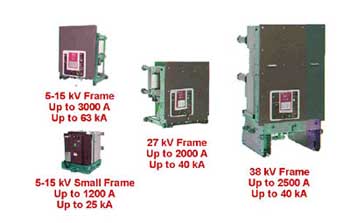
Figure 7. Typical medium-voltage circuit breakers using vacuum interrupter technology
Low-voltage power circuit breakers are equipped with stored energy mechanisms. This permits sequences of contact opening, contact re-closure, and contact re-opening, which can be activated either remotely or locally.
Low-voltage power circuit breakers can be serviced and maintained. This is important for applications where circuit breaker replacement is inconvenient and extended life is important. Further, these breakers are used primarily in draw-out switchgear. Thus, low voltage power circuit breakers typically are designed with rear-mounted primary disconnect contacts to permit the circuit breaker to be connected to and disconnected from the primary circuit stabs in the switchgear.
Low-voltage power circuit breakers receive single pole tests at 87 percent of rated interruption current at line-to-line voltage. This reflects the possibility of high single-pole fault currents in the upstream circuit location. In particular, such circuit breakers are suitable for corner-grounded delta-connected transformer applications.
ULs 1066 and UL 489 both cover similar continuous current ranges. However, since low-voltage power circuit breakers are applied upstream from molded-case circuit breakers, and since they typically supply several parallel downstream circuits, low-voltage power circuit breakers are usually high-continuous-current devices.
Low-voltage power circuit breakers are all rated to carry 100 percent of their rated continuous current within the switchgear. For molded-case circuit breakers in enclosures, the maximum circuit current is 80 percent of rated current, although 100 percent rated circuit breakers are available.
Medium-Voltage Vacuum Circuit Breakers
In low-voltage circuits, the magnitude of the circuit fault current is limited by the voltage developed across the arc drawn between the separating contacts. This arc voltage of tens or possibly hundreds of volts can approach the circuit voltage with resulting current limitation. However, in medium voltage circuits of 2.3 kV through 38 kV, the arc voltage is small compared to the circuit voltage, and the circuit breaker experiences the full available fault current.
The technology of choice for medium-voltage overcurrent protection is vacuum. Here each pole of the 3-phase circuit breaker contains a vacuum interrupter of deceptively simple construction. As indicated in the cut-away view of figure 6, two contacts oppose each other within a vacuum envelope.
During overcurrent conditions, the current-carrying contacts are separated and an arc is established in the metal-vapor evaporated from local hot spots that develop on the contacts. The circuit current is conducted through the arc plasma formed from the ionized metal vapor. During current flow there is continual evaporation from the local hot spots on the contacts with continual condensation of the ionized metal vapor on the broader contact surfaces and on the vapor condensation shield. At current zero the power input to the arc is removed and the evaporation ceases. However, the loss of inter-contact ionized vapor continues and a vacuum condition is re-established. Further, the contact polarity reverses. This results in a rapid change of the inter-contact region from an electrical conductor to an insulator within microseconds of current zero.
The keys to vacuum interrupter design are the selection and creation of the contact material, the design of the contacts for arc control, and the creation of a vacuum envelope that maintains a high vacuum condition for tens of years. Figure 7 shows typical medium-voltage circuit breakers using vacuum interrupter technology.
Electronics in Circuit Protection
Thermal-magnetic trip units are economic and compact. They have been used effectively and efficiently for many years. Their function can also be performed by electronic trip units. The first use of electronics, in the 1960s, was associated with protective relays for medium voltage circuit breakers. Since the early 1970s electronic trip units have been increasingly applied to power circuit breakers and the larger frame sizes of industrial/commercial molded-case circuit breakers. The present thrust is to make electronic trip units available down to frame sizes of 250 A and below. The advantage of electronic trip units is that time-current curves can be readily adjusted; both for phase current settings and for the settings of integrated ground fault units4. This flexibility permits coordination between series connected overcurrent protective devices such that, under fault conditions, only the device immediately upstream from the fault will clear the circuit. A further advantage is that the trip characteristic is independent of ambient temperature.
The electronic circuits on circuit breakers may also incorporate communications capability. At first this was limited to applications such as zone-selective-interlocking. Here an upstream power circuit breaker is set to trip with no intentional delay, but a trip-restraint-signal from a downstream circuit breaker can cause the power breaker to remain closed for settings up to 0.5 seconds, the maximum short-time duration. When a fault occurs on the load side of a selectively coordinated downstream circuit breaker, this downstream breaker communicates that a fault has been detected and the upstream power breaker then permits the downstream breaker to interrupt the fault. However, if the fault occurs between the power circuit breaker and the downstream circuit breaker, no restraint signal is received from the downstream circuit breaker, and the power circuit breaker will clear the fault without any intentional delay.
Communications capability is now used8 to transmit data to remote monitors or data acquisition systems. The initial information was limited to open/close status. This was followed by information on “cause-of-trip” and most recently by electrical metering data and by complete power quality data. In fact, it is now possible, from a remote location, to monitor and diagnose the electrical situation in a total industrial plant based on information communicated via the Internet.
Electronic advances have also increased the safety protection of residential circuit breakers. Ground-fault circuit interrupters have been available for many years9 and these circuit breakers, in addition to protecting the branch circuit wiring against overcurrents, provide personnel protection against electrical shock in cords and equipment connected to the outlets. Arc-fault circuit interrupters10 have been introduced during the past five years. These devices recognize the specific characteristics of arcing faults, and then interrupt the circuit. When combined with residential circuit breakers and located at the origin of the branch circuit, these AFCIs mitigate the effects of electrical arcs in the branch circuit wiring and in the cords connected to the outlets. Residential circuit breakers with combined GFCI/AFCI protection are also available.
Summary
Circuit breakers protect the circuit conductors against overcurrent. This is accomplished by first detecting the overcurrent and then interrupting the overcurrent with subsequent isolation. Thermal-magnetic trip units or electronic trip units detect the overcurrent. Interruption and isolation is accomplished by drawing an arc between separating contacts, with subsequent arc extinction. Circuit breakers can be broadly classified as low-voltage residential molded-case circuit breakers, low- voltage industrial/commercial molded-case circuit breakers, low-voltage power circuit breakers and medium-voltage circuit breakers. An overall electrical distribution system can be expected to incorporate all classes of circuit breaker. Electronics has increased the sophistication of trip units, including communications capability, and has permitted additional safety features such as shock-protection through GFCIs and enhanced fire protection through AFCIs.
1 NFPA 70,National Electrical Code2002, Article 100, (National Fire Protection Association, Quincy, MA, 2002), p. 70-37.
2 “International Standard for Low Voltage Switchgear and Controlgear, Part 1: General Rules,” International ElectroTechnical Commission Standard IEC 60947-1, Third Edition, 1999-02.
3 “UL Standard for Safety for Molded-case Circuit Breakers, Molded-case Switches, and Circuit Breaker Enclosures,” UL-489, (Underwriters Laboratories, Ninth Edition), October 31, 1996.
4 “Molded-case Circuit Breakers and their Application,” NEMA AB3-2001, (National Electrical Manufacturers Association).
5 “Guidelines for Inspection and Preventive Maintenance of Molded-case Circuit Breakers used in Industrial and Commercial Applications,” NEMA AB4-2000, (National Electrical Manufacturers Association). Recognized as an American National Standard (ANSI).
6 “UL Standard for Safety for Low-Voltage AC and DC Power Breakers Used in Enclosures,” UL 1066, (Underwriters Laboratories, Third Edition), May 30, 1997. Recognized as an American National Standard (ANSI).
7 Kimblin, C.W. and Long, R.W., “Comparing Test Requirements for Low Voltage Circuit Breakers,” IEEE Industry Applications Magazine, January/February 2000, p. 45-52.
8 Engel, J.C., Murphy, W.D., and Oravetz, D.M., “Remote Monitoring of Circuit Breakers,” Conference Record of the 1999 IEEE Industry Applications Conference, Phoenix, Arizona, October 1999, p.2344-2347
9 “Overcurrents and Undercurrents – All about GFCIs and AFCIs,” Earl W. Roberts, (Reptec, Mystic, CT), 2000.
10 Kimblin, C.W., Engel, J.C., and Clarey, R.J., “Arc-Fault Circuit Interrupters, The New Residential Electrical-Safety Technology,” IAEI News, Volume 72, Number 4, July/August 2000, p. 26-31.









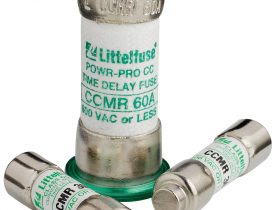
Find Us on Socials